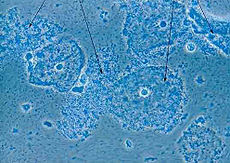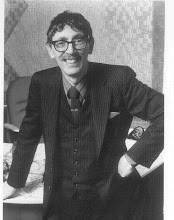
Tuesday, February 28, 2012
Monday, February 27, 2012
Sunday, February 26, 2012
Saturday, February 25, 2012
Friday, February 24, 2012
Thursday, February 23, 2012
Wednesday, February 22, 2012
Tuesday, February 21, 2012
My Latest HuffPost Blog:3 Intriguing Qs & As!

Dr. Franklin Ruehl, Ph.D.
Host, 'Mysteries From Beyond the Other Dominion'
GET UPDATES FROM Dr. Franklin Ruehl, Ph.D.
Like
26
A Trio of Intriguing Qs & As!
Posted: 02/21/2012 12:58 pm
Dr. Ruehl, can an ant survive being zapped in a microwave oven?
Most assuredly! Because most microwave ovens are characterized by so-called "hot spots," which are bombarded by microwaves, and "cold spots," which are free of them, an ant (or any other small insect) has a decent chance of surviving. This is tied into the problem of uneven heating due to "standing waves" formed when microwaves are reflected off of the oven's walls.
However, newer, more sophisticated models have minimized this problem, leading to more thorough cooking... and a reduced chance for the ant's survival within one!
Ruehl Fact: The fear of ants is termed "myrmecophobia."
Dr. Ruehl, are humans composed of stardust?
According to the "stardust hypothesis," the first generation of stars formed when the universe began with the "Big Bang" some 14 billion years ago. Within their broiling cores, heavier elements needed for human life, such as iron, were fashioned. As these stars died off, many as explosive supernovae, they yielded a reservoir of material in the form of titanic clouds of dust and gas from which succeeding generations of stars evolved, such as our own sun, with residual rings of material encircling them that ultimately coalesced into planets.
Hence, the planets, such as earth, should be composed of stardust. And accordingly, all life on such planets, including human beings, is hypothesized to be comprised of the essence of long dead stars!
While cosmological doctrine does hold that our sun evolved from gargantuan globules of cosmic dust and gas, there has been a debate as to whether those clouds were composed purely of stardust or of dust from rocky bodies, such as asteroids, that never were part of a star, or a combination of the two.
Intriguingly, astronomers have been analyzing interplanetary dust particles, or IDPs, which were retrieved from the earth's upper atmosphere by special NASA planes dubbed "High Altitude Dust Collectors." Incredibly, each IDP consists of approximately 100,000 individual minuscule grains, each only nanometers in diameter (billionths of a foot). Utilizing the new French NanoSIMs ion microprobe, astrochemists have thus far identified six grains that were definitely stardust originating from beyond our solar system.
Amazingly, they came from at least three different stars: a red giant; a metal-poor star; and a metal-rich star, perhaps a supernova. Overall, they determined that approximately 1% of interstellar dust is composed of actual stardust.
So it appears that we may owe a small part of our human condition to stardust, but not all of it. Obviously, further research is called for and is actually being conducted. For instance, the space probe Stardust, launched in February, 1999, has already collected several IDPs and has a rendezvous with the comet Wild 2 slated for January 2, 2004, where it will accumulate cometary particles, returning its cosmic sampling to earth after that time for a first-hand detailed analysis.
Ruehl Fact: In his book, "Vital Dust," Nobel Prize-winning chemist Christian De Duve argued that cosmic dust particles bearing organic compounds may have provided the basic building blocks for life on planets throughout the cosmic backdrop!
Dr. Ruehl, is there any way to recycle chicken droppings?
Incredibly, chicken dung may soon be utilized to clear up polluted water!
Researchers have recently created activated carbon pellets from fowl waste that have displayed a remarkable ability to absorb contaminant metals, such as copper, from water.
Use of chicken manure would combat two problems: the increasing cost of coal, which has provided the basis for activated carbon filters, and the disposal of chicken droppings which, up until now, have been of no commercial value.
Dr. Isabel Lima, research chemist at the Commodity Utilization Research Unit, Agricultural Research Service's Southern Regional Research Center in New Orleans, asserted, "It's turning poop to gold."
Saturday, February 18, 2012
Friday, February 17, 2012
Thursday, February 16, 2012
Wednesday, February 15, 2012
Tuesday, February 14, 2012
Monday, February 13, 2012
Friday, February 10, 2012
Thursday, February 9, 2012
Wednesday, February 8, 2012
My latest HuffPost Blog("3 More Intriguing Factoids")

Dr.Franklin Ruehl,Ph.D.
3 More Intriguing Factoids From the Sci-Fi/Horror/Mystery Genre!
Posted: 02/ 8/2012 11:39 am
Were Ingrid Bergman and Edward G.Robinson offered choice roles in "The Planet of The
Apes?" Did noted film noir producer Val Lewton make a grave error in 1943's "The Seventh Victim?" Was strongman Steve Reeves ever cast as Tarzan?
These are 3 engrossing film factoids from the sci-fi/horror/mystery realm that we now divulge:
- "Planet of the Apes" (1968) factoids: Ingrid Bergman rejected the role of the chimp physician Xira, with Kim Hunter then ably handling the part. Bergman later acknowledged that she came to regret her decision! Veteran actor Edward G.Robinson shot some scenes as the orangutan scientist Dr. Zaius, but, due to heart trouble, was physically unable to handle the role, which went to Maurice Evans. Although there were no seating restrictions during meal periods, actors portraying chimps, gorillas, and orangutans naturally gathered with their own species! No female actors portrayed gorillas or orangutans, only chimpanzees.
Ruehl Fact: Rod Serling created the twist "Statue of Liberty" ending, with astronaut George Taylor (Charlton Heston) suddenly realizing that he is back on earth. In the novel, the astronauts had landed on a different planet ruled by apes, but author Pierre Boulle asserted that he preferred Serling's surprise to his own conclusion.
- In 1942's Val Lewton classic, "Cat People," psychiatrist Dr. Louis Judd (Tom Conway) was clearly killed by the Cat Girl (Simone Simon). But, in Lewton's 1943 film, "The Seventh Victim," Dr. Judd, again essayed by Conway, returns in pefect health! Either they should have worked in some explanation as to his survival or simply given him another name.
Ruehl Fact: Tom Conway and his brother, George Sanders, were born in St. Petersburg,Russia to British parents. The family name was Sanders, so Tom became Conway. They worked together twice on film: in 1942's "The Falcon's Brother," Sanders, tired of the "Falcon" role after just 3 entries, suggested that his real bro replace him in the series, so his character, Gay Lawrence, was killed off in this 4th episode with his screen brother, Tom Lawrence, vowing to continue his anti-crime crusade, which he did for the next 9 Falcon films.
In 1956's "Death Of A Scoundrel," possibly Sanders' finest work, he turned his brother, Tom, over to the Communists in exchange for passage to America and as punishment for stealing his wife.
- Steve Reeves, the bodybuilder extraordinaire, gained a reputation as star of a long series of Italian sand-and-sword epics, ably portraying such notables as Hercules, Romulus, Phillipides,Glaucus, and Sandokan. But, why was he never cast as Tarzan, a role he appeared born to play?
Well, it turns out that at the very outset of his career, in 1949, he essayed the role of a Tarzan clone in a made-for-TV serial, "Kimbar of the Jungle." As with Tarzan, he wore a loincloth, swung through trees, and had a loyal chimpanzee companion! The 1st chapter was entitled, "The Lion Men of Tanganyika," and co-starred Virginia Hewitt, soon to become a regular on TV's "The Space Patrol."
However, unlike a typical serial, where the opening chapter was usually around 20 minutes to allow ample time to introduce the characters and develop the plot, this episode lasted under 12 minutes. Worse, it was the only chapter produced, perhaps because adequate financing was not forthcoming, so we will never know if Kimbar escaped from the lethal clutches of the Lion Men! For the record, this is not even included in his IMDB profile.
Unfortunately, Reeves severely dislocated his shoulder when his chariot crashed into a tree while filming "The Last Days of Pompeii" in 1959. While he continued to work despite excruciating discomfort, the malady ultimately forced him to retire in 1968 at just age 42. He died from lymphoma at age 74 in 2000.
Ruehl Fact: Steve Reeves was not related to George Reeves, star of TV 's "The Adventures of Superman," whose given name was actually George Brewer!
Tuesday, February 7, 2012
Monday, February 6, 2012
Saturday, February 4, 2012
Subscribe to:
Posts (Atom)

















